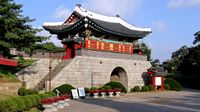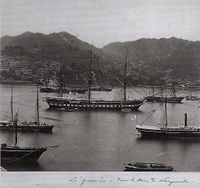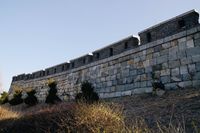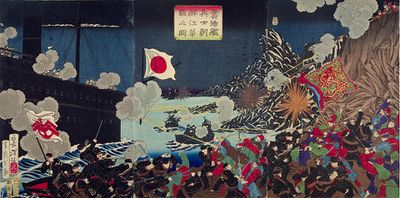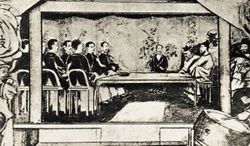GGHS 2019 Winter - Team 6
목차
- 1 Team
- 2 Military History and Ganghwa - Joseon Period and Contemporary International Relations
- 2.1 Why did we chose this topic?
- 2.2 French campaign against Korea of 1866(Byeongin Yangyo)
- 2.3 American Disturbance of 1871(Sinmi Yangyo)
- 2.4 UNYOHO incident of 1875
- 2.5 Korean-Japanese Treaty of 1876
- 2.6 Ganghwa island's geographical role
- 2.7 The role of Korea in the middle of the international society
- 3 Maps for historic sites
- 4 References
Team
| No. | Team Topic | Teacher | Role | Name (Korean) | No. of Students |
|---|---|---|---|---|---|
| 6 | Military History and Ganghwa - Joseon Period and Contemporary International Relations (군사-조선시대와 현대의 국제관계) |
Olga | Leader | 안태○ | 8 |
| Vice-Leader | 홍지○ | ||||
| 김은○ | |||||
| 남연○ | |||||
| 박채○ | |||||
| 정유○ | |||||
| 김성○ | |||||
| 김민○ |
Military History and Ganghwa - Joseon Period and Contemporary International Relations
Why did we chose this topic?
We participate the Ganghwa Girl’s High School Glabal Issues Forum in 2019 Winter. Friends who are interested in international relations and military facilities or events centered on Korea gathered. So, we tried hard to unite our various interest in one. As a result, we decided our topic Military History and Ganghwa – Joseon Period and Contemporary International Relations. We are going to deal with the incidents occurred in Ganghwa. Representatively, because there are many military events in Ganghwa, we picked up few representative events; French attack in 1866(Byeongin Yangyo), American Disturbance of 1871(Sinmi Yangyo), UNYOHO incident of 1875, Korean-Japanese Treaty of 1876. Focused on the role of Ganghwa and its meaning, we are tried to connect each military event to past and also to present. Through these activities, we are looking forward to inform the importance of Ganghwa for military and geographical region. Also, focused on Ganghwa, in 19 century, the thoughts for protection our own country developed. For these reasons we thought that we should put forth our efforts to protect and preserve region called Ganghwa. Lastly, we really hope that many people should recognize the importance of Gangwha as a role of protecting our country.
French campaign against Korea of 1866(Byeongin Yangyo)
Historical background
From 1849 to early 1863 Joseon was tolerant to Catholics. As a result, many French missionaries entered Korea and the general number of Catholics was growing. Meanwhile, in 1864 the Russian Empire approached the Joseon government with trade agreement. Catholic missionaries of Joseon Korea protested the alliance with France and Britain because it could have blocked trade with Russians.
However, both trade agreement with Russia and the alliance between the three countries was canceled. Heungseon Daewongunalso criticized missionaries for the irresponsible alliance proposal. In this situation, aiming to strengthen his authority and settle the uneasy public sentiment, Heungseon Daewongun enforced the law to suppress Catholicism.
Cause and Effect
Cause
In 1860 Joseon Korea’s neighbour Russia demanded trade and the right of Russian merchants to live in the Joseon Korea. At that time, Hong Bong-ju, a Catholic, proposed to Heungseon Daewongun to form an alliance with the U.K. and France via the help of the Catholic bishop, and use this alliance as a way to resist Russia. However, Heungseon Daewongun found out that Hong Bong Joo has been in contact with the West for a long time. Because of this, Heungseon Daewongun thought that Hong bong ju’s proposal was a scheme to gain profits and freedom for Catholics, and executed nine of the 12 Catholic missionaries from the West. This incident is called the Persecution of Byongin. Reidel, one of the survived French missionary, went to Tianjin and told Rose, the commander of the French Fleet, about the religious persecution against Catholicism in Joseon.
Deployment
After the occupation of the Ganghwa Ministry on October 16, Rose expressed his strong will to retaliate against 9,000 Koreans for the slaughtering of 9 missionaries. Because officials, soldiers and common people were all evacuated from the island the French army could occupy Ganghwado Island. Yang led the great army and secretly crossed the Ganghwa Strait in Deokpo to ambush Jeongjoksanseong Fortress. On November 9, under the orders of Admiral Rose, who was told about the maneuver of Koreans, a group of 160 men leaded by Olivier and armed with no field guns set out to attack the fortress.The Korean army attacked the French troops from east and south with artillery shells and won the battle.
Result
On September 8, when the admiral Rose seized Ganghwa, he looted a lot of cultural treasures such as silver bars and books of state rites. His fleet left the Kapgotjin on October 5 and headed to the Bupyeong area through the coastal waters of Deokjinjin. After the French army retreated, Joseon strengthened its military capabilities by reorganizing its military to prepare for Western invasion. Moreover Heungseon Daewongun made a new place of execution near Yanghwajin. The executions of Catholics continued until 1871. In addition, the government rejected trade and exchange offers with Western powers by implementing isolation policy.
Deokjinjin
.It was the center of the external capital that protected the Ganghwa Strait during the Goryeo Dynasty. After the outbreak of the disease, 12 steps including immunity, extramaritality, money band, and progress have been made as a way to protect Ganghwa Island.
Meaning and Influence
The Influence on the national and international affairs of Joseon and other countries
Before French campaign against Korea, Joseon tended to be submissive to foreign powers. However, when Heungseon Daewongun started to rule the country, Joseon not only resisted foreign powers but also won the war. This event not only changed the perception of Joseon by other countries but changed the international politics of other countries as well.
The Influence on Korean international affairs
Europe and the U.S. reexamined the relationship between Joseon and Qing and recognized Joseon as an independent sovereign state not a subordinate state to the Qing Dynasty.
Due to the continuous isolation policy of Heungseon Daewongun Joseon’s modernization was delayed. As a result, Korea was unable to cope with Japan's colonization later.
TThe Influence on other countries
The Far East policy of France was influenced: France has never again conducted an expedition to the Far East due to this failed trip to Korea. France has also rejected the U.S.’s proposal to attack Joseon together to retaliate for the General Sherman incident.
France-China relationship was affected as well: The failure of France's overseas trip to Joseon prompted the Qing Dynasty not to be afraid of France anymore. Because the Qing Dynasty considered Joseon a subordinate state, when it heard about France's defeat it no longer considered France a great power. This led to the burning of the French consulate in Tianjin and in clashes between Catholics and non-believers.
American Disturbance of 1871(Sinmi Yangyo)
Historical background
In the second half of 19th century the United States began to take an active interest in opening trade with Joseon. In August 1866, a US merchant ship called "the General Sherman" ascended the Daedong River and came to Pyongyang. However, because of the aggressive approach, the crew of "the General Sherman" was killed.
American punitive campaign
Following this incident, in 1871 the United States decided to launch a punitive campaign for the Sherman case. The US demanded compensation for the losses and the establishment of trade relations with Joseon Korea. All of these plans were bound to fail.
In 1871, the U.S. decided to make an expedition to Joseon to open its ports. When the U.S. fleet reached the Son Dol-mok area, it was attacked by the Ganghwa Fleet. On June 10, the U.S. landed in a Chojijin Fortress and the American War broke out. The Battle of Gwangseongbo Fortress was the most intense battle in Sinmyangyô. Sinmi Yangyo was recognized as the U.S. military's victory in the battle, but from the perspective of Joseon's position, handover line were driven away by a desperate fight.
Ganghwa Gwangseongbo Fortress
Gwangseongbo fortress used to play an important role guarding the Ganghwa Straits. It was one of the most intense battlefield in 1871. It is a place full of painful memories of how Korean people have lost their lives fighting to protect their land with their poor weapons.
Ganghwa Chojijin Fortress
This fortress was built to prevent invasion from the sea. where it fought against them when the United States and Japan invaded. In 1871, when US Marines invaded the superpowers, they were defeated by power defeats. At this time, military facilities such as gungwa, gunpowder warehouse were all destroyed. This historical site of national tribunal restored the castle and displayed the cannon of that time to become the superintendent of the patriotic spirit.
The situation after the Shin Mi-yangyo
The Colorado Lake and the U.S. military officers who were After the Battle in Gwangseongbo Fortress, Joseon built a monument that is written a motivational appeal to resist foreign invasions. With this opportunity, Daewongun started a policy of seclusion and ordered to set up monuments called Cheoghwabi all over the country. On these monuments is written a motivational appeal to resist foreign invasions.
Meanwhile, rumors have swirled around Seoul that a foreign ship had a battle and was greatly defeated, and Daewongun have banned evacuation outside the castle gate, keeping a low profile.
Affection and meaning of Shin Mi-yangyo
eave the text in bold and reorganize Shin Mi-yangyo was recognized as the U.S. military's victory in the battle, but from the perspective of Joseon's position, the two ships were driven away by a desperate fight.
The situation at home and abroad in Joseon Dynasty after Shin Mi-yangyo
"If Western barbarians do not fight for their invasion, they will be angry, and if they claim to be angry they will sell the country"
Heungseon Daewongun's policy of rejecting trade was to avoid trade with all Western countries, including Japan.However, the U.S. made a fuss over compensation and demands for a trade treaty under the pretext of the General Sherman incident (1866). Since then, Heungseon Daewongun built Anti-foreign Stele to promote the site of the rejection of the normal diplomatic relations.
UNYOHO incident of 1875
Historical background
After the Tokugawa shogunate due to the Meiji Restoration Japan succeed in the modernization. Growing ambitions of Japan made it seek the expansion of its influence abroad, as other Western countries did. Accordingly, Japan attempted to negotiate with geographically close Joseon but failed because of Heungseon Daewongun's policy of seclusion.
Cause and result
In 1873 Heungseon Daewongun stepped down and King Gojong became the next ruler. At this time, Japan sent Unyoho warship to Joseon with a plan to open the doors of Joseon, even by force. Before coming to the Ganghwa Island Unyoho harboured a port of Busan but hid its real purpose of arrival.
When Japan ship reached the Ganghwa Island, soldiers approached the island without any warning. Because of that, Joseon's military attacked the boat and the Japanese army returned to its battleship and shoot back. After landing in Yeongjongjin, the Japanese armed with modern weapons caused a great damage to the Korean military. Japanese troops looted 36 Joseon guns, 130 Hwaseong guns, and then withdrew. Aftermath.
After the battle Japan again came to the Ganghwa Island to force the Korean government to take responsibility for the incident. Also Japan wanted to impose a trade agreement on Korea. As a result, on February 26, 1876, Korea signed “Korean-Japanese Treaty ” and opened ports to Japan.
Significance and the Influence on Joseon national and international affairs
significance
The Unyo-ho incident is an event that foreshadowed the future opening of Korea to Japan. In the end, it was Japan's political maneuver that put the foundation for the invasion of Joseon Korea.
The Influence on Joseon national and international affairs
Previously, the countries including the U.S. and France, attempted to open Joseon's ports, but they failed. As a result, the ruler of Joseon considered their strategy of seclusion to be the right one. Actually this policy only slowed the modernization and worsen the international relations.
This incident, however, by gunboat diplomacy since the signing of 'Ganghwa Treaty' was due to forcibly open the doors and, after the case in Joseon Dynasty. United States and Since 1882 , Joseon has been concluded the treaty of trade with Britain, France, Germany.
Korean-Japanese Treaty of 1876
Korean-Japanese Treaty of 1876 is a treaty signed between Korea and Japan on the Ganghwa island.
Historical background
At that time, the resumption of the Heungseon Daewongun's esteemed regime and the introduction of the Min clan government led to a new turning point in the diplomatic negotiations. Also influenced the negotiations were the suggestion that it would no longer be beneficial to the national interest to refuse to do so.
However, the political atmosphere of the time gradually changed, unlike those who actively supported the policy of depressive government of Daewon County, which was influenced by North Korean studies and literature, and those who called for openness were growing. Meanwhile, the Qing Dynasty recommended that Korea be diplomatic with France and the U.S. while the news of Japan's political clique in Taiwan was growing.
Progress
On February 3, 1876, Japan finally signed a 12-trillion-dollar bill between Shin Heon and Kiyota Kuroda, the acting president of the Korean War, in order to engage in military negotiations over the Unyoho incident, which triggered the artillery attack on the coast by sending it to Ganghwa Island, the gateway to the capital.
The main articles of the treaty are the following. Joseon and Japan have equal rights (Article 1) . The two countries frequently send envoys to discuss the social affairs every 15 months (Article 2), and Joseon should open two ports other than Busan within 20 months (Article 5), which allows Japanese sailors to measure the shoreline for the sake of the safety of coastal navigation (Article 7), according to the criminal law between the two countries. In particular, Article 1 was intended to weaken the relationship between Joseon and Qing Dynasty, and Article 5 was intended to invade both politics and military other than trade by opening up Wonsan and Incheon. And Article 7 allowed us to explore the landing site during military operations by gaining the right to survey the coast of Joseon, and Article 10 was an unequal treaty that recognized extraterritorial rights.
Reinforced fortress across the Preamble yeonmudang (dusanekd) the Japan-Korea Treaty of 1876 is finally signed here as a place in Busan, Incheon, Korea, engaged by the Japan-Korea Treaty of our country from Wonsan.Open a port for Japan. As a place to sign the Sick Protection Treaty, this shaman warns that a monument must be erected here to keep the nation's self-centeredness in order not to forget the nation's dismal past.
Meaning and influence
Japan-Korea Treaty is one of the key events in Korean history. Even though it was unequal, it can be called the first modern treaty of Korea with foreign countries. Before, an agreements contained a request to a big country, but it was not the case with the Japan-Korea Treaty.
On one side, this treaty was a starting point for colonial aggression. On the other side, by opening ports Korea stepped on the course of modernization. Then again, the treaty became a policy turning point where conflicts between the autocratic and enlightened forces took place.
Internal and external situation after the Korean-Japanese Treaty of 1876
Japan-Korea Treaty of separate action, on the domestic Japanese diplomat's tour in the Joseon Period, opening settings of Japanese residents in the region and Japan.Japanese export and import of products for the exemption and unlimited in grain, and the circulation of money transaction documents, is permitted. This makes it easier for the shipbuilding industry to take protective measures against Japan's economic invasion.
Treaties with other countries
Japan-Korea Treaty credited not only with opening Joseon Korea to Japan, but also with opening Korea to Western countries. The United States, which failed to open up Joseon's doors by force, once again sought Japan's aid in diplomatic relations with the Joseon Korea when it signed a treaty with Japan. Around this time, in response to the advance of Russia's southernmost forces, there was also an argument that Joseon should establish diplomatic relations with the United States. In the end, in 1882 Korea signed additional treaties with Japan and the U.S. on the pretext of keeping Russian and Japanese forces in check. These treaties also and for the opportunity to obtain international final approval for Joseon's sovereignty.
In the first treaty signed by Joseon with several Western countries, the Treaty on the Defence of the Chōshimi, it prescribed that one of the two countries would help each other and make heavy adjustments in the event of pressure from a third country. However, the treaty was also an unequal treaty that stipulated extraterritorial rule and treatment of Choi Hye-guk by a consular court.
Joseon, which signed the treaty with the U.S., also established diplomatic ties with other countries, including Britain, Germany, Russia and France.
The advance into modern society
Ganghwa Island, Japan and the Joseon Dynasty by opening up to the Western nations, treaties, which first appeared in the international stage. Thus, it prepared an opportunity to develop into a modern society by accepting Western modern ideas and literary institutions. However, the opening of Joseon was forced by the capitalist expansion policy of the Tropics, and the import of modern Western civilization led to the invasion of the powers, including Japan, so Joseon also became the stage for the competition to invade these powers. With the economic invasion of the capitalist powers that followed the opening of the port, and the oppression and exploitation of the aristocratic classes became more severe, people's resistance began to expand day by day.
Therefore, Joseon after the opening of the gate had a national historic task of maintaining independence from foreign invasions, breaking old order and establishing a new order, and establishing a modern national state while protecting the people from double exploitation at home and abroad. Joseon, therefore, pursued reform in all sectors of politics, economy, society, and culture with the aim of establishing a modern state. However, the modern society of our country was unable to achieve the self-reliant modernization by itself amidst a series of autonomy, batting average, enlightenment, water polo, aggression and resistance, and ultimately suffered the hardship of being ruled by immigrants.
Ganghwa island's geographical role
Ganghwa Island, located at the mouth of the Han River, was frequently invaded by foreign powers for Seoul's threats. Therefore, the Ganghwa Strait is historically the most important maritime gateway in the defense and security of Joseon. In the past, the site was the military base for a 40-year-long anti-mongery campaign during the Goryeo Dynasty, and was the last bastion during the Byeongja Lake era.Thus, the entire island of Ganghwa has been fortified to prepare for foreign invasion. Especially, Byeongin Yangyo in 1866 and Sinmi Yangyo in 1871 were invaded by the great powers of the Gumi Empire in the second half of the 19th century. In response, the Joseon government has banned foreign vessels from sailing since Byeongin Yangyo.The monument was erected at the entrance to the Ganghwa Strait and all foreign ships were banned. Even domestic flights were banned without permission.
The role of Korea in the middle of the international society
In the middle of the heated competition of foreign power, from now on, there had been various incidents in Ganghwa such as invasion of foreign influence. Thus, the place “Ganghwa” withstanded invasion by other countries. In this case, Ganghwa shows strong spirits through some remains and historic sites. For now, Korea was developed a lot in many aspects of life. Typically, in the politic and societic part, Korea showed amazing development. Also, Korea encounter many difficult diplomatic problem among developed countries. Recently, in the terms of relationship with North Korea, many foreign countries such as China, U.S, Russia, and Japan are connected with Korea and they have much interested in relationship between North and South Korea. In this situation, there are few things that Korea should remember. First, we should remember the events in the past so that we cannot repeat the same problems. So, secondly, we should not repeat the same problem in the past like the Korean-Japanese Treaty of 1876. It was the very unequal agreement. We should remind these kinds of problems that was occurred before and reflect them in the present so that it can not be repeated. Therefore, we should improve our strength to deal with our on problem actively without the interference of foreign power.
Maps for historic sites
References
- 인천광역시 문화유산 - 영문 해설문 포함 (한국학중앙연구원)
- AKS Wiki
- ↑ French campaign against Korea(WIKIPEDIA )
- ↑ French campaign against Korea(Contents of Korean History)
- ↑ The Reillumination of Byeonginyangyeo Incident - Fighting between the Chosun and the French Army(DBpia)
- ↑ United States expedition to Korea(WIKIPEDIA)
- ↑ American Disturbance(KCM.Cornp)
- ↑ Ganghwa Island incident(WIKIPEDIA)
- ↑ 운요호 사건(DOOPEDIA)
- ↑ 운요호 사건(DOOPEDIA)
- ↑ 우리역사넷(NATIONAL INSTITUTE OF KOREAN HISTORY ALL RIGHT RESERVED.)



